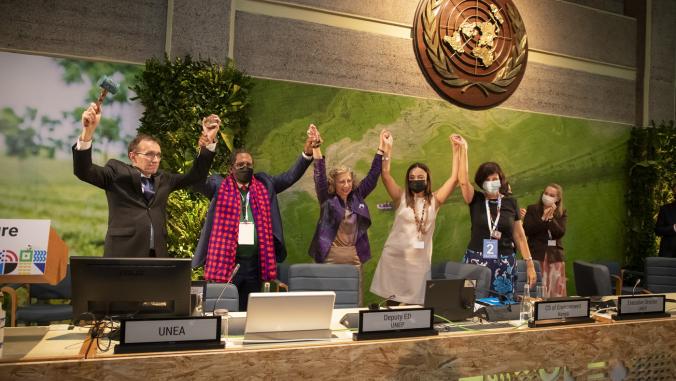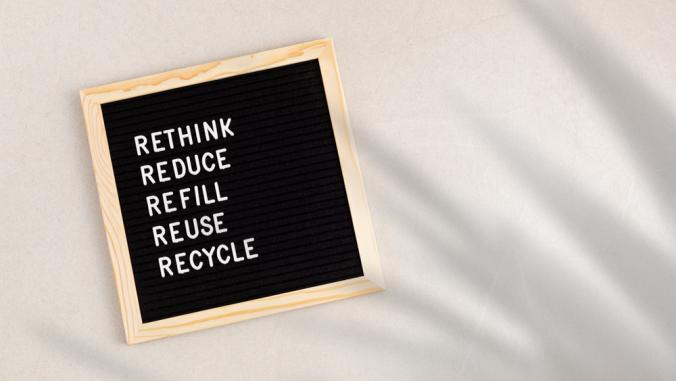Apple dials up its circular materials aspirations
The electronics giant is showing how to reclaim and reuse valuable materials that previously had largely gone to waste.

Since Apple announced in 2017 its ambitious goal of making all new iPhones, Macs and other products from 100 percent recycled or renewable materials, its progress has been hard to track. Without a public target or timetable, it has been unclear if the industry-leading announcement would move markets, or merely fade into the forgotten realm of unmet aspirations.
If the latter, Apple wouldn’t have been an outlier. Just 20 percent of global e-waste is collected and recycled under appropriate conditions, while the other 80 percent is thrown into the residual waste stream or dumped, traded or treated in substandard conditions, according to a recent report by the Ellen MacArthur Foundation. In 2016 alone, 44.7 million tons of e-waste were generated globally, 435 thousand tons of which were mobile phones.
This week, however, Apple grounded its aspirations in action, publicly sharing materials recovery rates, details on the incorporation of high-value materials back into new products and announcing a new R&D facility in its 2019 Environment Report, released today.
Here are five things to know about today's announcement:
1. She’s not your grandma's Daisy
Apple’s material recovery robots, known as Daisy, are growing up. Now able to disassemble 15 iPhone models at the rate of 200 per hour, each Daisy robot can theoretically disassemble more than a million devices per year.
Of course, that’s just a fraction of the more than 216 million iPhones that Apple sold in 2017 alone, but it represents a meaningful step towards materials recovery and reuse.
To improve recovery and recycling rates, Apple is expanding its takeback program through partnerships with Best Buy and Dutch telecom company KPN, which will accept Apple’s customer returns. According to today’s report, Apple refurbished more than 7.8 million devices in 2018, diverting more than 48,000 metric tons of e-waste from landfills.Daisy can disassemble 15 iPhone models at the rate of 200 per hour, theoretically more than a million a year.
But don’t expect to see Daisy in an Apple store near you. "We decided on a model where things come to Daisy, Daisy doesn’t go to things," Lisa Jackson, Apple’s vice president of Environment, Policy and Social Initiatives, told me this week. "I think that makes a lot of sense economically."
2. The Apple doesn't fall far from the tree
Apple already is incorporating some materials from disassembled products in new products. This includes cobalt from iPhone batteries, aluminum from MacBook Air enclosures, tin from the solder on logic boards and copper from seven iPhone components.
While the recovered materials represent just a fraction of the 60 or so elements found in an iPhone, Apple prioritized the highest-value raw materials based on their environmental, social and supply impacts.
3. There's still a lot to learn
Apple also announced that it is opening a 9,000-square-foot Material Recovery Lab to drive innovation in recycling and device disassembly. The lab, housed in the same Austin, Texas, facility as Daisy, will partner with academic institutions and has a stated intention of benefitting the broader recycling industry as well as other electronics companies to help solve the global e-waste challenges.
"There’s new technology needed," said Jackson. "In some cases, recycling hasn’t made the strides forward that technology has. We need to make sure that we’re investing in recyclers and in the recycling field."
4. It's important to share
Apple’s ambitions extend beyond its own operations and has committed to sharing R&D findings with industry.
"We want to drive solutions that change the way the world does business," said Jackson. "That was the reason we set the circular supply-chain goal in the beginning, because we want to change the way that people see electronics manufacturing, starting with our products."
Apple has a long track record of leveraging it’s scale to effect change. For example, today’s news comes on the heels of last week’s announcement that 44 of its suppliers have committed to powering their production of Apple products with 100 percent renewable energy.
5. There's still more to do
Apple’s closed-loop aspirations haven’t yet addressed the ability to easily repair and upgrade its products, in particular by third parties, a fact that continues to rankle some critics.
"Rather than another recycling robot, what is most needed from Apple is an indication that the company is embracing one of the greatest opportunities to reduce its environmental impact: repairable and upgradeable product design," Gary Cook, senior IT sector analyst at Greenpeace USA, said in a statement last year. "This would keep its devices in use far longer, delaying the day when they’d need to be disassembled by Daisy."
Still, Apple is making strides toward a circular model of materials flows and showing how to reclaim and reuse valuable materials that previously had largely gone to waste. And that’s a valuable contribution to the burgeoning circular economy.
As Jackson put it: "I think Apple’s attention here is part of wanting to change the way the world does business."





